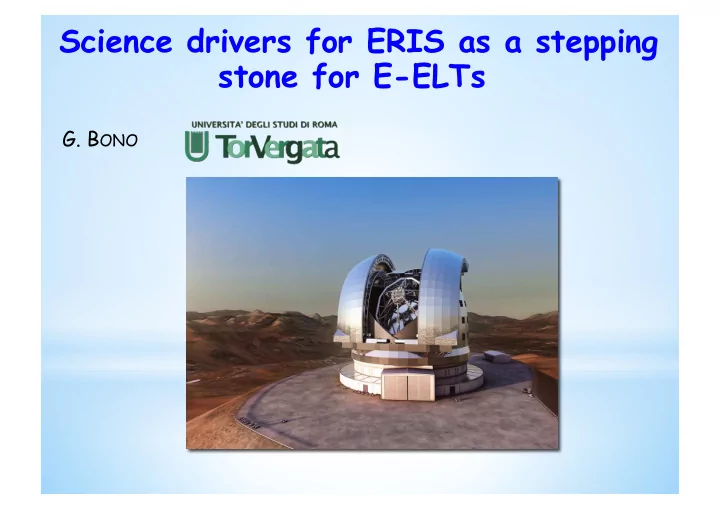

Science drivers for ERIS as a stepping stone for E-ELTs G. B ONO
Setting the scene E-ELT in a nutshell First light instruments ERIS Paving the way for E-ELT Future Perspectives
First Generation E-ELT Instruments First Light E-ELT -- CAM (MICADO): R. Davies E-ELT -- IFS (HARMONI): N. Thatte E-ELT – MIR: L, M, N: B. Brandl MAORY (AO module) E. Diolaiti 4) E-ELT – HIRES (Optical – NIR) 5) E-ELT – MOS: Fibers + IFUs (optical, NIR) 6) E-ELT – Not defined yet
E-ELT CAM: MICADO Plus SCAO + MCAO (MAORY) NIR long-slit medium resolution spectrog.
MICADO@E-ELT vs NIRCAM@JWST FoV ~1’ X 1’ 2 X (2.16’ X 2.16’) Pixel scale ~3 mas + “HR” ~30 mas K-band ~29.5 ~30 J-band ~31 ~29.5 t_exp=5 hrs -- S/N=5 -- MAORY + 6 LGS -- seeing 0.06 high efficiency filters AB Mag -- HR 1.5 mas smaller FoV F115W & F220W -- t_exp=5 hrs -- S/N~5 Extraction region in a circle of 0.8” Synergies among JWST, EUCLID & ERIS@VLT
NIRSPEC@JWST FoV ~3’ X 3’ for MOS Slit width ~200 mas Slits Micro Shutter Array Fixed slits IFU (3”” X 3’’) Spectral Resolution R~100 0.7 -- 5 μ m (single prism) R~1000 1 –- 5 μ m (3 gratings) R~2700 1 –- 5 μ m (3 gratings) R=100 t_exp ~ 10,000 sec point source continuum at 3 μ m S/N=10 is AB~26 mag Synergies between JWST & ELTs
E-ELT Integral Field Spectrograph: HARMONI Plus SCAO + LTAO 33,000 spaxels per exposure!
Requirements for IFS@E-ELT in J,H,K-band FoV > a few arcsec High multiplex > intrinsic Spatial res. < 0.004—0.005 arcsec Abundances (Iron, α -, s-, r-elements) High-res R ~ 20,000 Limiting mag. K~23 mag CRIRES (+GIANO+WINERED) crucial preliminary steps
E-ELT METIS Coronagraphy in L & N bands N-band polarimetry Diffraction-limited imaging in L, M & N bands FoV 18 x 18” Low resolution slit spectrograph (R < 5000) IFU high-resolution spectrograph in L & M bands, FoV 0.4 x 1.5” and resolving power of ~100,000 .
Adaptive Optics SCAO, MCAO, MOAO, LTAO HERE & NOW ….. But life isn't a bed of roses!!
In the beginning was …. MAD@VLT Marchetti + (2007) GB + (2010) t~11±1 Gyr K WJK J-K
Later on was FLAO@LBT SCAO M15 core (pcc) FWHM of 0.05 (J) & 0.06 (Ks) arcsec . Strehl ratio ⌫ 13–30% (J), 50–65% (Ks) Limiting magnitudes: J~22.5 mag Ks~23 mag J-band image Esposito + (2010)+lecture Drift of the PSF shape at larger Distances from the NGS
The absolute age of M15 LUCI (4x4arcmin): 19J 20-40 sec 20K 20 sec PISCES (26X26arcsec): 30J 30 sec K 30K 15 sec WFC3: F160W(H) 3X200+6X250sec t= 13±1 Gyr Monelli et al. (2015) J-K J-K F160W-K
Symmetric vs asymmetric PSF ROMAFOT FLAO@LBT M15: core Fiorentino + (2014) Schreiber + (2014)
… and more recently GEMs@Gemini Rigaut + (2014) Turri + (2015) NGC1851 core K F606W-K Two DMs + 5 Na LGS to deliver Detection of multiple populations a FoV of 83” X 83” in the SGB confirming opt. findings
ERIS@VLT [2019/2020] Imager (NIX) Enhanced Resolution Imager & Spectrograph FoV 27x27, 54x54 arcsec^2 1-5 µm for UT4 Pixel scale 0.013, 0.027 mas/pix [AOF, laser] + SCAO Spectral coverage J -- M
ERIS@VLT [2019/2020] Integral Field Spectrograph (SPIFFI) FoV 8x8, 3.2x3.2, 0.8x0.8 arcsec^2 Pixel scale 250—25 mas/spaxel Spectral coverage JH K R up to 8000
Cepheids in the Galactic centre and … beyond!! Similar for type II Cepheids Matsunaga + (2013, 2015)
Unveiling the inner bulge ~25,000 RR Lyrae by OGLE IV Census far from being complete! Pietrukowicz + (2015) VVV JHK~16-18
Complete census of the old stellar populations in the Galactic spheroid Nuclear Bulge In situ vs accreted formation µ = 14.5 Ak ~ 2.5—3 K MSTO-MSK~ 3.5—5 mK ~ 22-23 (10 σ ) mH ~ 23 mL ~ 20.5 TRGB M81, Cen A μ ~28-29 Virgo ( μ =30), Eridanus ( μ =32) J-L Coma ( μ =35) SPITZER
Metallicity distribution Fourier parameters of light curves Peaked at [Fe/H]=-1 Zoccali + (2008) RC+RG stars broad range from -1.5 to super solar Is there evidence of a metallicity gradient? & the α -element distribution?
New open questions: There is tripe for SPIFFI!
GLOBAL GROWTH Evolutionary, Pulsation, Atmosphere models 1D vs 3D Opacity, EOS, line identifications, molecules (NIR) Multiband Asymmetric PSF Integral field spectroscopy
Conclusions 8-10m class telescopes are paving the way to E-ELTs: Photometry & Spectroscopy Community (tech.+science) has to grow learning from our previous mistakes!
Recommend
More recommend